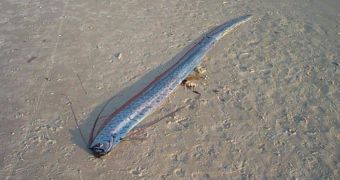In a set of observations that may very well be unprecedented, researchers have finally managed to secure some video footage of the giant oarfish in its natural element, as the monster fish was swimming in the Gulf of Mexico. Biologists know of no other occasion on which the animal – which is possibly the largest bony fish in the ocean – was observed while swimming in its element. Stories of the fish exist however, but they revolve around dead specimens that washed ashore years ago, and that have been mistaken for sea serpents, PhysOrg reports.
The creature is very peculiar, especially when considering that its back is covered by an undulating fin, and that adults can grow to be about 17 meters (55 feet) long. Unfortunately, science doesn't have a very clear record of datasets on the marine beast, which some consider to have spawned the sea-serpent myths. Many researchers believe that this is the largest fish to boast a solid spinal cord and vertebrae in the world's oceans, given that no larger vertebrates have been discovered since men took to the sea, thousands of years ago. The oarfish goes by the catchy Latin name Regalecus glesne.
The team that found the living specimen was led by Mark Benfield, who is a professor at the Louisiana State University, in Baton Rouge. He and his team were using remotely operated vehicles (ROVs) to scout the area below the Thunderhorse semi-submersible oil rig, located in the Gulf. Such surveys are regularly conducted in cooperation with companies such as Shell, BP and Chevron, so as to assess the impact that the drilling operations have on the natural ecosystems. The investigation, a part of the Serpent project, was ran by the National Oceanography Center, Southampton (NOCS).
The animal discovered during such a routine mission was between five and ten meters (15 and 30 feet) long, and it started swimming very strangely when the ROVs approached. It moved downwards relatively fast, swimming tail-first. The machine followed the oarfish around for about five minutes, filming it and its behavior, and then resumed its survey duty. By undulating its dorsal fin in the waves, the researcher says, the fish caught quite a high speed while diving backwards, which is a very uncommon type of locomotion for fish.

 14 DAY TRIAL //
14 DAY TRIAL //